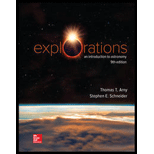
(1.1) What is the celestial sphere? What are the celestial equator and the ecliptic?
The celestial sphere, celestial equator, and the ecliptic.
Answer to Problem 1QFR
The celestial sphere is an imaginary sphere that contains Earth at its center and all celestial objects inside are seen inside surface of the sphere including yourself when it is seen from space and the celestial equator is the equator which is above the Earth’s equator. The line or path that the Sun trace across the celestial sphere is called ecliptic.
Explanation of Solution
Celestial sphere; in this sphere all celestial objects are seen on the inner surface of the sphere and all are at same distances from the center of the Earth but actually they are positioned at different distances from Earth and this sphere rotates about same axis of Earth rotates.
Imagine that when we are seeing the night sky, all stars are seen on the dome of the sphere and this dome is stretched to the horizon, usually here the upper half of the sphere are seen (north celestial sphere) when we are in above the equator and lower half of the celestial sphere (south celestial sphere) seen when we are in below the equator.
Celestial equator is an equator where the celestial sphere and the plane of the terrestrial equator intersects.
On the celestial sphere, the path traced by the Sun as it moves through the constellation is called ecliptic.
Conclusion:
Therefore, the celestial sphere is a sphere which spins the celestial pole that lies above the Earth’s pole and celestial equator is the equator of the celestial sphere, also the path traces by the Sun on the celestial sphere is called ecliptic.
Want to see more full solutions like this?
Chapter 1 Solutions
Loose Leaf For Explorations: Introduction To Astronomy
Additional Science Textbook Solutions
Mathematical Methods in the Physical Sciences
University Physics Volume 1
Introduction To Health Physics
College Physics: A Strategic Approach (3rd Edition)
Physics for Scientists and Engineers: A Strategic Approach with Modern Physics (4th Edition)
- Is the ecliptic the same thing as the celestial equator? Explain.arrow_forwardWhy does the number of circumpolar constellations depend on the latitude of the observer?arrow_forwardFrom where on Earth could you observe all of the stars during the course of a year? What fraction of the sky can be seen from the North Pole?arrow_forward
- What is the point on the celestial sphere representing the extension of the axis of Earths North Pole? (18.1) (a) North celestial pole (b) core (c) vernal equinox (d) celestial equatorarrow_forwardHow is the position of a star designated in the sky?arrow_forwardDescribe a practical way to determine in which constellation the Sun is found at any time of the year.arrow_forward
- What is the angular distance from the north celestial pole to the point on the sky called the vernal equinox? To the summer solstice?arrow_forwardIf a star rises at 8:30 p.m. tonight, approximately what time will it rise two months from now?arrow_forwardIf you were to drive to some city south of your current location, how would the altitude of the celestial pole in the sky change?arrow_forward
- Explain how the zodiacal constellations are different from the other constellations.arrow_forwardWhere are you on Earth if you experience each of the following? (Refer to the discussion in Observing the Sky: The Birth of Astronomy as well as this chapter.) A. The stars rise and set perpendicular to the horizon. B. The stars circle the sky parallel to the horizon. C. The celestial equator passes through the zenith. D. In the course of a year, all stars are visible. E. The Sun rises on March 21 and does not set until September 21 (ideally).arrow_forwardOn the day of the vernal equinox, the day length for all places on Earth is actually slightly longer than 12 hours. Explain why.arrow_forward
 AstronomyPhysicsISBN:9781938168284Author:Andrew Fraknoi; David Morrison; Sidney C. WolffPublisher:OpenStax
AstronomyPhysicsISBN:9781938168284Author:Andrew Fraknoi; David Morrison; Sidney C. WolffPublisher:OpenStax
 Foundations of Astronomy (MindTap Course List)PhysicsISBN:9781337399920Author:Michael A. Seeds, Dana BackmanPublisher:Cengage Learning
Foundations of Astronomy (MindTap Course List)PhysicsISBN:9781337399920Author:Michael A. Seeds, Dana BackmanPublisher:Cengage Learning Stars and Galaxies (MindTap Course List)PhysicsISBN:9781337399944Author:Michael A. SeedsPublisher:Cengage Learning
Stars and Galaxies (MindTap Course List)PhysicsISBN:9781337399944Author:Michael A. SeedsPublisher:Cengage Learning An Introduction to Physical SciencePhysicsISBN:9781305079137Author:James Shipman, Jerry D. Wilson, Charles A. Higgins, Omar TorresPublisher:Cengage Learning
An Introduction to Physical SciencePhysicsISBN:9781305079137Author:James Shipman, Jerry D. Wilson, Charles A. Higgins, Omar TorresPublisher:Cengage Learning Stars and GalaxiesPhysicsISBN:9781305120785Author:Michael A. Seeds, Dana BackmanPublisher:Cengage Learning
Stars and GalaxiesPhysicsISBN:9781305120785Author:Michael A. Seeds, Dana BackmanPublisher:Cengage Learning





